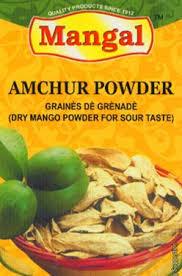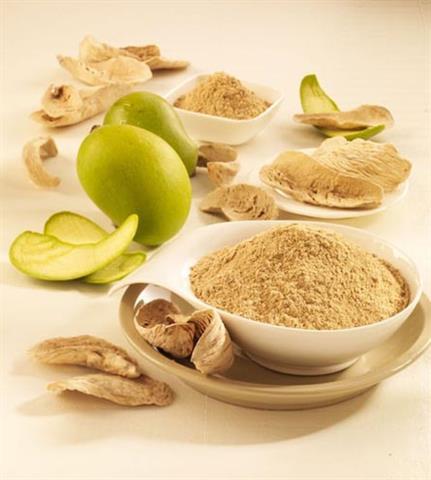AMCHUR (DRIED MANGO POWDER)
Contents
- What is Amchur?
- Mango in Hindu Mythology
- Mango Folk Lore
- Spice Description
- Mango Tree Specifications
- Etymology
- Major Health Benefits
- Focus on Dental Hygiene
- References
 What is Amchur?
What is Amchur?
Mango fruit is native to the whole region falling underIndia-Burma-Malaysia province and is recorded as one of the oldest cultivated fruits in the world. As per the facts, in India, the cultivation of mango is prevalent since 4,000 years. Following its European explorations in 16th and 17th centuries, the mango tree extended its presence to various tropical and sub-tropical regions in the world, including Africa.
 Besides being consumed as a normal fruit, there are various other usages of mango and one such use is in its powdered form. The sun dried green mango powder is called amchur. The term ‘amchur’ is a Hindi name derived from two words namely ‘am’ or ‘aam’ meaning mango and ‘chur’ meaning powder. Amchur making is a simple process in which the green unripe mangoes are first sliced into pieces and then sun dried for hours before they are finally ground into fine powder.
Besides being consumed as a normal fruit, there are various other usages of mango and one such use is in its powdered form. The sun dried green mango powder is called amchur. The term ‘amchur’ is a Hindi name derived from two words namely ‘am’ or ‘aam’ meaning mango and ‘chur’ meaning powder. Amchur making is a simple process in which the green unripe mangoes are first sliced into pieces and then sun dried for hours before they are finally ground into fine powder.
Mango in Hindu Mythology
In Hinduism and Buddhism, mango tree is highly revered as a tree having many granting abilities. Hindu mythology and various rituals followed in the religion show how a mango tree holds special position amongst the Hindus.
The mango, apart from its place as a fresh fruit, is most famous as a chutney or pickle ingredient. Lord Buddha was presented a mango grove. History says that Mogul King Akbar (1556-1605) once set a campaign for planting over 1, 00,000 mango trees as part of the promotion of mango cultivation in India.
In Hinduism, Mango is considered extremely sacred and is mentioned in the Ramayana, the Mahabharata and the Puranas. The Hindus consider mango as a symbol of fertility and love. The leaves are extremely auspicious and in many social, religious and nuptials rites the leaves are specifically used during pujas and other propitiations.
Mango Folk Lore
There are various interesting legends and folklores related to the origins of mango.
One story says the daughter of the Sun was a beautiful princess who got married to a rich and powerful king on earth. However, there was an enchantress who was extremely jealous of the princess. The enchantress started following the princess everywhere. Over time, her jealousy increased and she started threatening the innocent princess. Fed up with the enchantress, the kind princess dived into a pond and emerged out as an extremely beautiful lotus. The prince then fell for the lotus and spent hours looking at it. This was unbearable for the enchantress and she ended up burning the whole pond. From this point, the burnt lotus grew as a mango tree. The prince was extremely disappointed on losing his favourite lotus. However, after seeing the mango tree he fell for it and kept waiting for the day to taste the first fruit of the tree. When the first mango ripened fully, it dropped onto the king’s foot and from its fresh ripened pulp splashed out the beautiful princess. On this note, the story ended happily and the couple lived peacefully ever after.

There is another legend associated which explains how mango became the symbol of love. A girl once picked a mango flower and asked Kamdeva or cupid to attach it to the tip of one of his arrows. The arrow worked so well that cupid made mango flower dart the symbol of love.
As per another legend, once, as part of a playful act, Parvati veiled Lord Shiva’s eyes and the whole world fell into darkness. When Parvati realised her mistake she decided to perform severe austerities by installing and praying to Shivalinga under a mango tree. Shiva got delighted and he decided that his beloved should now get united (ekya) unto her Lord (nath) under the same mango tree. It is said that at the Ekambaranath temple in Kanchipuram, the 3,500 year old trunk of the mango tree still lies across the corridor of the temple. However, there is a graft version of the tree which is present in the compound of the temple. It is also said that the four branches of this mango tree represents four Vedas and in symbolic interpretation the four branches bear fruits of different shapes and size.
Spice Description
 Good quality amchur is finely ground powder with somewhat fibrous texture. Sliced dried mangoes are either light brown or orange brown while the readied powder is generally pure beige. The spice is warm, sour-sweet and slightly resinous. It is slightly sweet and acidic in flavour.
Good quality amchur is finely ground powder with somewhat fibrous texture. Sliced dried mangoes are either light brown or orange brown while the readied powder is generally pure beige. The spice is warm, sour-sweet and slightly resinous. It is slightly sweet and acidic in flavour.
Cooking with Amchur is mainly prevalent in India. The acidic flavouring works as a replacement to tamarind and lemon in Indian culinary. Mango has natural astringent and antiscorbutic properties and hence amchur powder adds natural piquancy to curries, marinades, chutneys and condiment.
Ideally amchur could be a good substitute for a number of spices and ingredients including tamarind paste, pomegranate seeds, lime juice pomegranate powder, hibiscus powder and sumac ground, lemon peel powder, pumpkin powder.
Mango Tree Specifications
Mango tree is immensely popular for its bark, flowers, fruit, seed, resin and leaves.
Various parts of the mango tree –
Tree – Evergreen Tropical Tree
Height – 10-40 m (30 – 130 ft)
Life span – 100 years
Structure – Healthy tree with extremely dense protruding canopy
The Trunk – Rough, multiple branched, greyish-brown
The Leaf – Shiny and Dark Green
The Flower – Five-petal, tiny, either pink or cream, flowers grow on twigs, flowers open in the wee hours and during night time
The Fruit – Medium-sized, sweet, rounded oblong drupes, green to orange, thickish skin, sweet orange flesh, and fibrous, large flat stone like seed in between the fruit
Ideal Climate – Tropical regions, wet and dry seasons, dry period essential for good flowering and fruiting, adaptability towards wide variety of soils and even in semi-wild state, biennial cropping, propagated by seedlings
Family – Family members include cashew and pistachio
Etymology
It is said that the term mango is derived from the Tamil word ‘mangkay’ or ‘mangay’. Later, during the Portuguese invasion, the fruit came to be known as ‘manga’ which later took the name ‘mango’.
Scientific Name of Mango: Mangifera indica, Mangifera, Mangifera indica L.
French: mangue
German: mango
Italian: mango
Spanish: mango, manguey
Indian: Aamchoor, Aamchur, Amchoor, Amchur, Umchoor
Major Health Benefits
Amchur powder contains many health benefits. Some major health benefits of this powder are mentioned as below –
- High citrus acid content i.e. Vitamin C prevents scurvy
- Effective germicide
- Protection against heat stroke
- Works wonders in quenching thirst
- Rich source of Vitamin A (beta-carotene)
- Rich source of Vitamin E and Selenium
- High vitamin content provides protection against heart disease and many other ailments
- Powerful antioxidant and anticancer abilities, high concentration of phenols and phenolic compound
- Mango has high resistance power because of presence of iron, people suffering from anemia are prescribed to take mango in fruit or powdered form
- Its high level of antioxidants are good for skin and low in carbohydrates
- It combats poor digestive system and helps combat acidity
- It also has other healing factors including antiviral, antidiabetic, antiinflamatory, antifungal, antimicrobial, hepatoprotective, anti-allergic, and hypoglycaemic.

Focus on Dental Hygiene
In an experiment, ten dental plaque causing bacterial strains were tested against antibacterial activity of the amchur extract. The results showed the extract contain strong antibacterial activity which could curb the growth of both Gram-positive & Gram-negative bacteria. Amchur extract is found most resistant in fighting against Bacillus sp., Staphylococcus mutans and Pseudomonas sp. It was also explored as a part of the research that in comparison to chlorhexidine, amchur was more beneficial in prevention of dental caries infection.
http://www.celtnet.org.uk/recipes/spice-entry.php?term=Amchoor
http://www.ispub.com/journal/the_internet_journal_of_microbiology/volume_7_number_1_31/article/antibacterial-activity-of-amchur-extracts-on-some-indigenous-oral-microbiota-causing-dental-caries.html
http://www.myspiceblends.com/glossary/A/amchur.php?expandable=0&mdex=amchur
http://www.my-indian-food.com/Amchoor.html
http://bhort.bh.cornell.edu/conservatory/cpage3.html
http://herbpathy.com/Uses-and-Benefits-of-Mango-Powder-Cid53
http://redscarabtravelandmedia.wordpress.com/2013/03/30/pulp-fiction-indias-mango-trail/
http://homecooking.about.com/od/foodlore/a/mangolore.htm
http://champagnemango.com/history/mangos-in-culture-lore-legend/
Encyclopedia of Healing Foods By Michael T. Murray, Joseph Pizzorno
